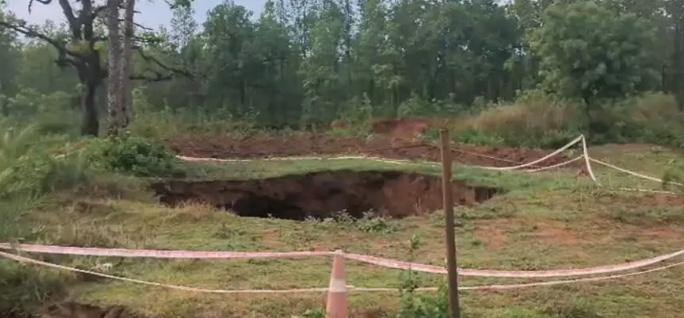Bhubaneswar: A section of the under-construction Khordha-Bolangir railway tunnel near Adenigarh in Odisha’s Boudh district collapsed on Monday, creating a significant 30-meter long crater and raising serious concerns about infrastructure safety and construction protocols in challenging terrains.
While initial reports indicate no casualties, the incident has brought railway development projects under intense scrutiny.
The collapse, which occurred earlier today, has severely disrupted work on the critical Khordha-Bolangir railway line, a project vital for enhancing connectivity in the region, officials admit.
Eyewitnesses reported a sudden subsidence, leading to the formation of a large depression where the tunnel was being excavated. Emergency response teams from the railway authorities and local administration were immediately dispatched to the site to assess the situation and secure the area.
Upon receiving news of the cave-in, railway engineers, disaster management personnel, and local police swiftly arrived at the Adenigarh site. The primary focus was to ensure no workers were trapped within the collapsed section.
Fortunately, preliminary checks suggest that all personnel working in the vicinity at the time of the incident managed to evacuate safely, averting a potential tragedy. However, the collapse has brought construction to a standstill, and the timeline for the completion of this crucial railway link is now uncertain.
The incident highlights the inherent risks associated with large-scale infrastructure projects, especially those involving tunneling through complex geological formations. The Khordha-Bolangir line traverses diverse landscapes, including areas known for their challenging soil and rock conditions.
While the exact cause of the Adenigarh tunnel collapse is yet to be officially determined, a multi-disciplinary investigative team has been constituted to probe the matter. Experts suggest several factors could contribute to such an event:
- Geological Instability: The region’s geology, characterized by varied rock strata and potential fault lines, could be a significant factor. Hidden loose patches of fractured or weak rock, undetectable during initial surveys, can lead to sudden subsidence.
- Water Seepage and Ingress: Heavy rainfall or underground water channels could have saturated the surrounding soil and rock, reducing their shear strength and eroding support structures over time. Water inrush is a common cause of tunnel failures during construction.
- Construction Methodology and Support Systems: Questions may arise regarding the adequacy of the temporary and permanent support systems used during excavation. Issues such as improper lining installation, cold joints in concrete, or insufficient rock bolting could compromise structural integrity.
- Blasting Operations: If the tunnel was being constructed using drill and blast methods, the vibrations from controlled explosions could potentially destabilize already fragile rock masses if not meticulously managed and monitored.
- Overburden Thickness: In areas where the overburden (the material above the tunnel) is shallow, the tunnel can be more susceptible to collapse if the ground conditions are not adequately supported.
A senior civil engineer, speaking anonymously, stated, “Tunneling in geologically active or unpredictable terrains, like many parts of India, demands continuous, real-time geological assessment and adaptive engineering solutions. Any oversight in understanding the ground conditions or in implementing robust support systems can have severe consequences.”
The investigative team is expected to employ a range of techniques to ascertain the precise cause of the collapse. This will likely include:
- Detailed Geological and Geotechnical Surveys: Utilizing advanced methods like Tunnel Seismic Prediction (TSP) and Complex Frequency Conductivity (CFC) to map the subsurface geology, identify fractured zones, and detect hidden water pockets.
- Structural Analysis: Examining the design specifications, construction logs, and material quality used in the tunnel section.
- Drone Surveys: Deploying drones for remote visual inspection and LiDAR scanning of the collapsed area, especially if human entry is deemed unsafe due to ongoing instability.
- Review of Safety Protocols: Assessing adherence to established safety standards, training of personnel, and the effectiveness of monitoring systems in place during construction.
The findings of this investigation will be crucial not only for understanding the Adenigarh incident but also for informing future railway and infrastructure projects across the country, particularly in challenging geographical areas. The focus will be on implementing more stringent geological investigations, enhancing real-time monitoring, and adopting adaptive construction methodologies to prevent similar occurrences.
The East Coast Railway authorities have assured a thorough and transparent inquiry, promising to take all steps to prevent such incidents in future.


